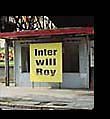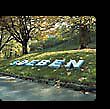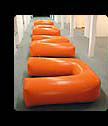|
|
Philip Ursprung, Zurich
Published in "L/B", collection cahier d'artistes, Pro Helvetia 1998
Cool afternoon
Had I been walking through the Lorraine quarter of Bern one afternoon in the autumn of 1996, then I might have noticed the message “Inter will Roy” (“Inter wants Roy”). It was placed on a large, yellow sign in front of the empty window of a defunct news stand. Even if I hadn’t known that behind it was the “Kiosk im Kunstkanal”, a – albeit meagrely – subsidised exhibition space for contemporary art, I would still have realised that “Inter will Roy” was an  artistic product. Conditioned by countless outdoor exhibitions, we have learned that a message without a sender in public space has to be art. artistic product. Conditioned by countless outdoor exhibitions, we have learned that a message without a sender in public space has to be art.
I would have clearly identified “Inter will Roy” as a commentary on painting (like many other passers-by in this quarter teeming with artist’s studios). The theme has been in the air constantly thanks to the commitment of the Kunsthalle as well as several galleries and collectors in Bern. In fact, Bern put itself on the international map in the late eighties as one of the last bastions of the hard-pressed medium of painting and the associated remnants of the late modernist discourse on high art.
“Inter will Roy” would have reminded me of the exhibition of the American painter Christopher Wool that was on view at the Bern Kunsthalle a few years ago. On his large-format works, Wool generally paints messages on a white ground, whose lettering seems to spill out of its stencilled abstraction, generating a painterly effect by dripping down the picture surface. Wool’s speciality is the creation of surfaces painted with thickened black oil paint that trips viewers up in a kind of mimetic reflex. For, in front of these paintings, we become not only viewers who perceive shape but also readers who decode messages and are thereby drawn into an abyss of meanings.
Thus conditioned, I would probably have begun to examine the panel in front of the news stand more closely, reading the letters not only from top to bottom but from back to front as well, in order to prolong the pleasure of the viewing experience. I would have gone up close to the artefact, looked behind it, viewed it from different angles and at varying distances. I would have murmured the words to myself to see if their melody also yields a meaning. But I would have been disappointed in the end because the message was not on the panel. The letters had been cut out of it, the message had literally vanished into thin air. The surface had nothing painterly about it. There was neither a mystery nor an aura to its materiality. It would have made no difference how long I looked at it or whether I was facing an original or only a reproduction. As a matter of fact, I never did see the original. I have seen it only in reproduction, as a computer printout in colour in the artistic documentation of Sabine Lang and Daniel Baumann. But being an ignoramus in matters related to football, I did learn something about the iconography of this piece that I would not have known by seeing the original alone. “Inter will Roy” quotes a headline announcing the fact that the Italian soccer club Inter Milano wanted to hire the trainer of Switzerland’s national team, Roy Hodgson. The headline was splashed across the front pages in news stands all over the country for an entire day. It was thus more concretely in the air than the debate on painting in Bern.
Obviously, a connoisseur of football will realise that “Inter will Roy” refers to the world-class football club Inter Milano, just as an art connoisseur will recognise the reference to the world-class artist Christopher Wool. The weight of the two references is comparable. The balance or composition of different elements, which traditionally determines the “quality” of painting, is achieved through the equivalence of references to two distinct areas of public interest: art and sports. But this encounter is meaningful only within the framework of the specific outdoor exhibition situation. In the neutral spaces of exhibition architecture, such as the white museum cube or a Kunsthalle, the contextual meanings constructed by Lang/Baumann would seem arbitrary. However, given the backdrop of a defunct news stand, a narrative emerges in which the individual elements are fused into an allegorical whole.
The news stand, or rather its ruins, provides both the physical and the narrative setting for the encounter. The artists are certainly not interested in nostalgically tracking down the lost aura of the news stand and celebrating peeling layers of paint as indicators of past, “real” time. Nor are they interested in reacting to “real” space and formally addressing the architectural givens. Like the yellow placard, the physical identity of the object “news stand” is secondary. Lang/Baumann do not explore the spatial and temporal dimensions of the news stand as such, but rather its functional and historical dimensions. The venue they have chosen once housed an institution in which various aspects of public life and untold varieties of representing reality were crowded together in the smallest of spaces. This was the home of an endless and seamless array of fact and fiction. Here, one could watch news become stale almost before it had been read. Here, the great events of world politics were at readers’ fingertips and yet ever so remote. Here, headlines vied with each other to pique the curiosity of passers-by. Here was the promise of happiness in the form of lottery tickets, and here, one learned about the unhappiness of others in the form of catastrophes, natural and otherwise. “Inter will Roy” refers to the fact that these functions are no longer in effect at this particular site, without succumbing to the propensity for nostalgic recollection. Although “Inter will Roy” functions on the level of the monument and is directed towards various aspects of public life, its messages are so ambivalent that the work serves as a point of departure for a host of new stories and fictions.

In addition to the dialectical juxtaposition of headline and reality, Lang/Baumann juxtaposed “Inter will Roy” with an actual physical event of modest proportions that took place at the opening. They organised a table football championship inside the news stand. This rather old-fashioned game perfectly suited the dilapidated premises. Obviously, it was more limited and more ”artificial” than a real world-cup champion-ship, and fewer people from the neighbourhood gathered there than would have in the course of an ordinary news-stand day. But, like a model, it was related to both realities because it was unique, ephemeral, entertaining – and self-consuming.
“Inter will Roy” contributes to the currently reactivated debate on art in public spaces – how ever one may define it – because, in contrast to many other contemporary projects, it is not “site-specific” in the sense of a static reaction to spatially fixed objects. Instead, the site specificity of the piece is subject to historical change and receptive to spontaneous responses. Lang/Baumann’s approach may undoubtedly be interpreted within the framework of what James Meyer calls a “functional site” 1. The two artists investigate not only the structural dimensions of their exhibition context but, above all, they take a dynamic approach to the exploration of narrative and historical dimensions. Instead of long-term furnishings and artistic appropriation of space, they opt for temporary animation of public spaces. Instead of telling a story with an end defined a priori, they offer fragments of potential beginnings.

And indeed, their first contribution to public space follows this logic: “E 15” (Burgdorf 1996) entails a series of adverbials, like forthwith, some day, just now and therefore, which could stand at the beginning of a story. These words, cast in coloured concrete and laid out along the embankment of a curving street, arouse one’s curiosity without making too many promises. There is not the slightest indication that the artists, or rather the interpreters, know more about the possible stories than any other reader. The very idea that the chunks of concrete could contain an answer to the puzzle is ruled out by definition. This indifference implies a critique of art’s claim to authoritative presence. The artists’ attitude is even more explicit in “Undo” (Rome 1997), an installation that consists of inflated plastic pillows that fill the room by spelling out the computer command: “undo”. This is the ultimate act of deleting something just begun. The gesture of a provisional start that is instantly cancelled out again in order to make room for the next start is here perpetuated – at least as long as the pillows are still filled with air.

Linguistics call such incomplete narrative patterns “elliptical”. So it comes as no surprise that the two artists have chosen to use the ellipse of a toy racecourse as an attribute of their double self-portraits, which is in effect a paradoxical trademark. Like the model cars that always have to negotiate the same chicanes and indefatigably roar around the same curves, the scenarios staged by L/B also always follow precisely predetermined tracks. Their preference for slightly old-fashioned materials, for toys and models, underscores their scepticism towards perfection and self-referentiality. They counter the late modernist dogma of eternal novelty with constant retardation. The “developments”, the “future” of their figures are as predictable as the course of their colourful racing cars. They do not get bogged down in infinity. They do not risk their necks. Nor do they have any secrets. They keep catching up with their own promises. And one could watch for hours.
Philip Ursprung
1 Cf. James# Meyer, The functional Site in: Platzwechsel,
ex. cat. Kunsthalle Zürich: Zurich 1995, pp. 24 - 39. Cf.
also Miwon Kwon, One place after another:
Notes on site specificity, in: October 80, Spring 1997, pp. 85 - 110. |
|